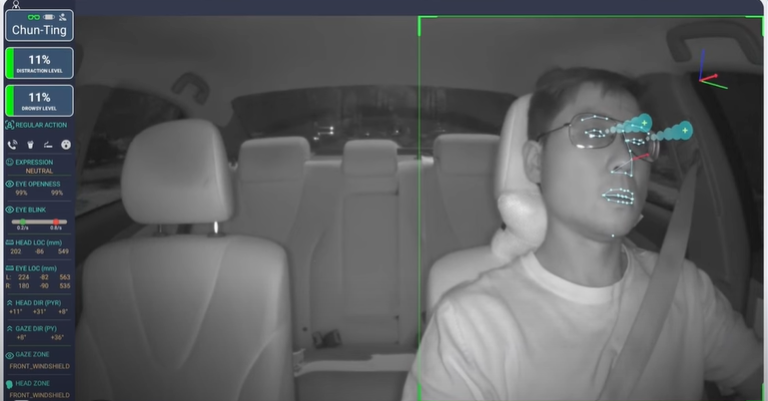A change in European regulations will require the installation of a driver distraction and drowsiness monitoring system.
Others are reading now
Taking a moment too long to look at the dashboard’s center screen triggers a car to display a “Look at the road” icon, accompanied by lights designed to redirect the driver’s gaze forward. This scenario, tested in Forvia’s equipment laboratory, will soon become a common feature for drivers.
Starting July 7, 2024, every new car model manufactured in Europe is required to include a system capable of directly detecting drivers’ distraction and drowsiness levels. This mandate comes under the European regulation known as “GSR2” (“General Safety Regulation 2”).
Mandatory in Europe
This move is detailed in the Delegated Regulation (EU) 2023/2590, established by the European Commission on July 13, 2023. According to the regulation, the system must alert drivers if their eyes deviate from the road for more than 3.5 seconds at speeds above 50km/h, and for more than 6 seconds when traveling between 20 and 50km/h.
This requirement applies regardless of the time of day, and the system must be effective even if the driver is wearing accessories such as caps, sunglasses, or false eyelashes.
Also read
Driver Monitoring Systems (DMS) are not entirely new to the automotive industry, with certain vehicles having incorporated them since July 2022.
“This type of system already existed but it was not very widespread. What already existed for the first version of this regulation were detection systems based on different types of sensors on the steering wheel or other parts of the vehicle,” Ayla Vanden Driessche, Forvia’s business development manager for driver assistance systems, explains.
“They were able to determine or estimate, based on the movements of the steering wheel, how to maintain the direction of the vehicle, whether the driver seemed perhaps distracted or inattentive, or even had the beginnings of drowsiness. With this regulatory development, this will become mandatory in Europe and be much more widespread,” the expert adds.
Ayla Vanden Driessche further explained that the updated regulation calls for more precise and widespread implementation. Infrared cameras, capable of detecting various facial points, including eyelid closure rates and head orientation, are identified as the most effective means for this purpose.
Beyond Safety: The Future of Driver Monitoring
Like the intelligent speed limiters which will also arrive this summer, this time on all new cars, this regulation is part of the ambition of zero deaths by 2050 on the roads of the European Union. According to French road safety, the first signs of drowsiness increase the risk of having an accident by 3 or 4.
In the summer of 2026, all new cars sold in Europe will have to carry these cameras.
In addition to promoting safety, the widespread adoption of these systems opens the door to innovative applications aimed at enhancing driver comfort.
“This type of system is capable of providing other information or detecting other elements such as the driver’s emotions to offer music, adjust the interior ambiance, or to combine this information with the DMS. For example, depending on where the driver is looking, we can adjust the brightness of the screens to provide greater comfort or highlight important information,” Ayla Vanden Driessche considers.
Applications which are still at the prototype stage.


